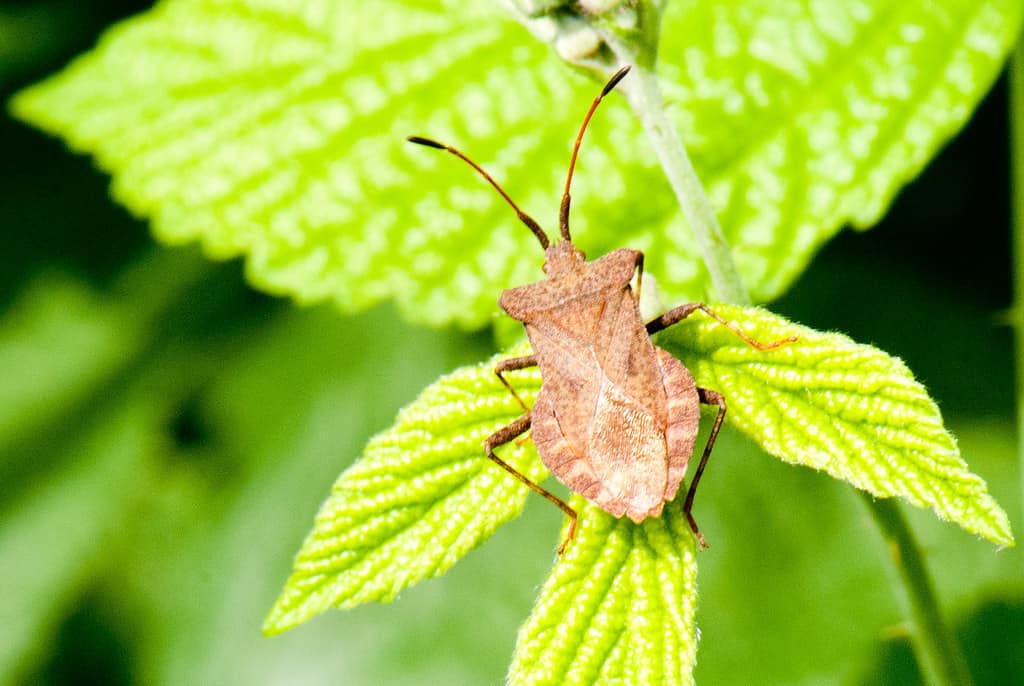How did the brown stink bug get its name?
The brown stink bug was named for its brown hues and for the foul odor it produces when threatened. The smell has been described as “a pungent odor that smells like coriander.”
Native to Asia they have become an invasive species in the United States and parts of Western Europe. Their population has exploded to a point where they are now considered serious agricultural pests.

Do brown stink bugs bite and sting?
Brown stink bugs are classified as a nuisance, but they do not bite or sting humans as their mouthparts are constructed for sucking not biting.
It is noted, however, that the brown stink bug can have harmful effects on humans. Although rare, people have been known to have allergic reactions to the defensive chemicals produced when threatened. In most cases, they are known to be irritating to human skin and eyes.
Do brown stink bugs fly?
Brown stink bugs are considered excellent fliers. They can travel over 1.2 miles over 24 hours, but given their size and clumsiness – that is quite the feat. Field observations have seen them flying in a straight line at nearly 7 miles per hour.
Their flight capabilities have enabled them to spread over North America and Europe rapidly. First observed in the United States in 2001 they are now present in at least 40 states.
What do brown stink bugs eat?
Many of the stink bug family are similar in their plant-focused diets. Some are known to be predators of other insects, but in the brown stink bug’s case – they mainly feast on crops of fruits and vegetables. They are prominent consumers of peaches, apples, pears, green beans, soybeans, cherries, and raspberries. That versatility makes their diet a concern for agricultural life.
As a sucking insect, the brown stink bug doesn’t bite into the fruit or vegetable it’s consuming. Farmers and those who raise crops will notice that the products have dimpled or dead-looking areas on the surface. Their exploding population has meant that they are a significant pest due to the damage they cause to crops. They have been known to infect crops 30-40 feet from the edge of the field.
Where do brown stink bugs come from?
The brown stink bug originates from eastern Asia and is widespread in China, Japan, South Korea, and Taiwan. The insect was first discovered in North America in 1998 – where it is believed to have stowed away in a shipping container.
They were introduced to Western Europe under similar circumstances – where the brown stink bug was identified in a container of tiles from Chin, also in 1998. Since then, they have spread across the European continent.
How long do brown stink bugs live?
Brown stink bugs have an estimated lifespan of around 6-8 months. However, this can vary considerably. Their longevity depends on the food sources available to the insect, the temperature , and the general climate. The creature lives longest in temperate, moist areas where they can reproduce for elongated periods.
Should they discover houses to take residence – the brown stink bug has been known to live up to a year. They will enter homes around autumn when the weather gets cooler. The insects will typically go into a state of hibernation – but within a home can remain active due to heat and light.
Why are brown stink bugs considered such a pest?
Brown stink bugs are verified as a serious agricultural pest. Their population increase and feeding habits have massive destructive potential to essential fruit and vegetable crops. As seen in the Eastern United States and Europe – they can cause millions of dollars in damage every year. The insects feed on the plants by using their sickles to pierce the plant and extract fluids. Crops lose essential fluids, delay maturation, and become vulnerable to more destructive pathogens.
Brown stink bugs are also a pest to homes. They don’t feed on any home materials or bite or injure humans or animals – but their sheer numbers can be a nuisance. When temperatures get cooler – they can enter homes in droves – as many as 26’000 brown stink bugs were once discovered in a single house. In line with their name, they emit a foul odor when threatened and can irritate human eyes and skin.
